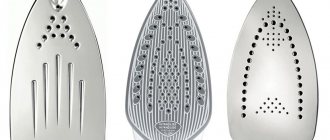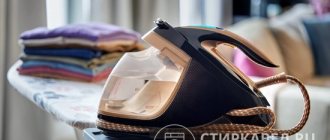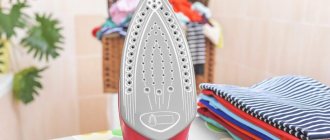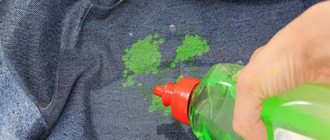Six simple tricks to save your iron sole
Every housewife has burned the bottom of her iron at least once in her life. Brown burnt marks interfere with ironing white and delicate fabrics. It is very difficult to clean, but there are many ways to deal with this problem at home.
The reason for the formation of carbon deposits on the soleplate of the device is incorrect setting of the temperature during ironing.
Before you start cleaning, you should look at what material is at the base of the iron sole. Modern products have different coatings: Teflon, stainless steel, ceramics, metal-ceramics.
Why does this problem occur?
NOTE! If you don’t need the theory, then you can immediately start repairing, but I still advise you to read it.
To put it roughly, we have a BGA chip falling off the PCB. As a result, the contacts from the chip do not come into contact with the PCB. And then we observe “Artifacts”: cubes, diamonds, stripes, color changes on the screen and other visual defects. To understand what is happening, let's look at the image below.
We have a standard video chip that is installed on almost all video cards.
- Here we have a PCB on which the chip is located.
- Next come the microscopic balls.
- And the silicon crystal itself.
As a result of prolonged work, these balls become covered with cracks, which in turn become oxidized. During oxidation, contact with the textolite completely disappears, and we get the same problem with artifacts.
Here the question arises: “How can we remove oxidation and artifacts from the monitor?” – the answer is quite simple. It is necessary to heat these balls to a sufficiently high temperature and then the oxidation will disappear and contact will be restored.
Salt cleansing
You can clean metal surfaces with salt:
- Heat the device to maximum temperature, then turn it off.
- Sprinkle fine salt onto a piece of cloth or a sheet of white paper.
- Without pressing, move the iron over the sprinkled salt.
Special iron cleaning products
Special products that are sold in hardware stores also help to get rid of old carbon deposits on the bottom of irons. It's easy to use. They are no less effective than improvised means. Here are the most popular ones:
Cleaning liquid
The variety of liquid products for removing blackness from the burnt bottom of an iron is amazing. This is Dr. Cleaner. Beckmann, Synergetic, Freshbubble spray and others.
Their composition and properties are approximately the same. Cleaners have a good effect on old soot and carbon deposits, removing blackness quickly and effectively.
They are easy to use:
- shake the jar
- distribute the product onto the sole, leave for 5-15 minutes,
- wipe with a clean sponge.
If carbon deposits remain, repeat the procedure again.
Iron cleaning pencil
Outwardly similar to a paraffin candle, but white in color, with a pleasant smell if the manufacturer has added a fragrance. The pencil contains organic acids and urea. You can buy the cleaning product at hardware stores, household appliance markets, or order online. The iron cleaning pencil looks like this:
You need to use it step by step like this:
- Open a window in the room to allow fresh air into the room. When using a pencil, a strong and pungent odor is released.
- Prepare your work area. Place unnecessary material on the ironing board, and a small piece of foil under it.
- Heat the iron to maximum temperature. Then turn off the device from the network.
- Take a pencil and run it along the burnt bottom. But touch only the outside; try not to touch the handle and plastic parts.
- When the paste begins to crackle and boil, run the iron over the fabric to remove the product along with carbon deposits from the surface of the device.
- The bottom of the iron has cooled down, now wipe it with a damp cloth. Clean the steam holes with ear sticks.
Manufacturers claim that with the help of a pencil, you can remove burnt synthetic fabric and polymer residues from the soleplate of the iron if a plastic bag accidentally melts on it. The main thing is that it acts safely, without damaging the surface; it is impossible to scratch the Teflon coating with it. Therefore, many housewives, despite the unpleasant smell, consider pencils the most effective remedy .
On a note! If the iron does not turn on after cleaning or has stopped working, you can correct the situation by disassembling the device and cleaning its contacts. Most often, the problem occurs after using salt or soda. The substances oxidize electrical contacts, rendering them inoperable. Carry out repairs at a service center.
Cleaning with soda
Soda is a softer abrasive, so even a Teflon iron can be processed.
Cleansing with baking soda:
- Pour 3 tsp into a small amount of water. soda to make a thick paste.
- Heat the iron, then turn it off.
- Use a sponge to apply the paste to the areas of burnt tissue.
- Hold for 5-6 minutes.
- Wipe with a sponge.
Using foil
One of the fastest and easiest methods for removing burnt fabric is using foil. To do this, take a small piece of regular aluminum foil with a large thickness, spread it on an ironing board and iron it several times. This method allows you to remove carbon deposits from almost any surface in a couple of movements, but you need to be careful when cleaning, as heated foil can burn your fingers.
Vinegar cleaning
You can clean ceramic and metal surfaces with vinegar. The advantage of this method is that it cleans not only the sole, but also the steam vents.
Actions:
- Pour a little vinegar into the pan.
- Place the sole of a cold iron in vinegar. It is important that only the sole is wetted.
- Leave for 25 – 30 minutes.
- Rinse the bottom of the device with water, let it dry, then iron the piece of dense material.
Another way:
- Soak a piece of cloth in vinegar (table vinegar).
- Wipe the slightly heated device.
Analysis of the video card
- First, completely disconnect all wires from the video card.
- Remove the side cover. I will also check the hardware itself for integrity. There are no traces of burning or smell.
- Turn off additional power.
- Unscrew the fixing bolts.
- On some motherboards, you need to press the white tab to turn the holder off. Next, simply pull the card upward.
- I have a card: AMD Radeon HD 7970 from . But quite a lot of “vidya” are treated in this way.
- We need to remove the cooling system - radiator and fans. To do this, you need to unscrew all visible screws from the back. Also check that there are no traces of burning or any drips.
- To “pry off” the heatsink from the video card, I had to apply quite a lot of force. Apparently as a result of long work they have grown to each other.
- We erase the old thermal paste from the radiator. The thermal pads are in good condition, so there is no need to replace them. Yes, and they are quite expensive. A little dusty, but you can just wipe them off.
- I advise you to inspect the capacitors and transistors for swelling and leaks. If any are found, they will need to be soldered. In my case everything is fine.
- Remove the thermal paste on the chip itself - this can be done with a regular cotton pad.
Using soap
Take laundry or liquid soap. With these available tools, you can remove even very heavy dirt.
How to clean:
- Heat the device slightly.
- Soap a piece of wet cloth.
- Wipe off the carbon deposits.
- Remove any remaining product and deposits with a clean cloth.
Preventive measures
[blok_4_h2]
To ensure that the need for “general” cleaning of the iron arises as rarely as possible, you should follow simple measures to prevent the appearance of soot and scale:
- Set the correct temperature depending on the type of material. When ironing delicate fabrics and wool, cover the items with gauze or cotton cloth.
- Use purified or distilled water depending on the manufacturer's recommendations.
- Activate the self-cleaning function two to three times a month.
- After each use, wipe the iron with a damp towel.
Cleanliness of the iron is not only an aesthetic requirement. An appliance whose holes are blocked by scale and whose soleplate is contaminated with carbon deposits works less efficiently and damages things. You can clean it using industrial and home remedies. It is important to act carefully and take into account the features of the working surface. Cleaning should be carried out regularly, in this case it is easier to get rid of dirt.
Special pencil
Expensive Tefal should be cleaned with a special pencil:
- Preheat to 130 degrees, place in a vertical position.
- Using light pressure, move the pencil along the sole without touching the steam vents. The deposits will disappear quickly.
- Iron the piece of cloth to remove any remaining melted pencil.
How to remove burnt fabric
If you forget to turn down the heating temperature of the device and touch something made of synthetic fabric, then expect an unpleasant surprise. Sticky traces of synthetics are not so easy to remove.
You can clean it using the means described above, or it is better to use a paraffin candle:
- Warm up the sole.
- Wrap one edge of the candle with cloth.
- Move the candle from bottom to top over the hot surface, tilting it slightly so that the paraffin does not fill the holes for steam to escape.
- After cooling, wipe the bottom with a damp cloth
Prevention and care tips
Preventive measures when using the iron
If you don’t want to often think about how you can clean the iron and how to do it correctly, do not neglect preventive measures. These simple rules are suitable for any iron if you clean Brown, Tefal, Philips, etc.:
- Do not fill the iron with tap water . It contains too many salts and heavy metals, which negatively affects the parts of the device. Make a choice in favor of clean water - bottled, filtered or boiled.
- Do not leave water in the iron . After ironing, drain the remainder into the sink.
- If you don't know how to clean your iron from burnt fabric, try wet cotton . Apply it to the crash site, this should help to get the fabric separated from the sole.
- When ironing, use scented products . They not only give a pleasant smell, but also serve as a means of preventing scale.
- , etc. Especially if you are cleaning a ceramic or Teflon coated iron.
How to clean an iron from burnt polyethylene
If suddenly the device comes across a plastic bag. How to free it from the film? In this case, solvent or clear nail polish remover will help.
Film removal process:
- Heat the iron.
- Moisten a soft cloth in solvent, wipe the burnt sole, unplugging the device.
- Wash off any remaining residue with warm water and soap.
The gentle method with salt will also clean the surface well: add finely planed paraffin to the salt, then move the surface of a household assistant over this mixture.
If your home assistant is coated with Teflon, you must act very carefully. Devices coated with Teflon smooth out all types of fabric well.
In order not to deprive them of their clear advantage over other products, it is worth using simple means.
- Vinegar 70% will cope with the problem perfectly. Moisten a napkin with vinegar and place a hot iron on it. Let it sit for several hours. All you have to do is wipe it with a cloth.
- A special pencil will also carefully clean the Teflon coating.
When you buy an ironing device, you read that it has a “non-stick coating.” This note reassures you: your device will always be in perfect condition. But no one can give a guarantee that the sole of the household assistant will not darken. Therefore, be careful when ironing, set the correct heating mode.
You can see different inscriptions on T-shirts. If you touch them with an iron, you can find stuck material at the bottom of the home helper.
You can get rid of stuck plastic using a hydroperite tablet. Heat the device, unplug it, rub it with a tablet. Very soon the dirt will begin to fall away.
All methods are also suitable for removing paint from fabric. If this happens, try a gentle method - wipe with a solution of citric acid. Dissolve one tablespoon in a glass of water. Dampen a cloth and wipe the base of the household appliance. Acid will corrode any dirt.
Traditional cleaning methods
Experienced housewives know exactly how to clean the iron from burnt marks on the sole, and advises doing it in the following proven ways:
- Citric acid.
- Toothpaste.
- Soda.
- Salt.
- Vinegar.
- Hydrogen peroxide.
- Chalk or melamine sponge.
- Laundry soap.
- Paraffin.
It’s worth mentioning right away that not all of the listed methods for removing carbon deposits are suitable for modern electric irons. You need to choose a method for getting rid of carbon deposits taking into account the coating of the ironing sole.
Our grandmothers had ordinary ironing equipment, without a delicate Teflon coating that is scratch-resistant. Therefore, they cleaned the metal sole with abrasive substances (soda, salt), rubbed with hard brushes and got excellent results.
This means that we will consider only those folk remedies and life hacks that help to properly clean the sole from burnt fabric and polyethylene and will not allow the device to be damaged. Let's look at each of them in detail.
Cleaning the iron with a melamine sponge
- Lightly wet the sponge with water of any temperature.
- Gently rub dirty areas on the sole until they are clean.
The advantage of this method is that the eraser does not scratch the surface and does not require the application of additional cleaning agents. In addition to the iron, you can use a sponge to remove carbon deposits from pots and gas panels.
But people with allergies should use it very carefully, since melanin, the material from which the sponge is made, is toxic.
Coarse salt
We do not recommend this method if you have a Teflon-coated model. If you have an old grandmother's iron, then this method will work.
Coarse table salt helps to easily clean the sole from carbon deposits. It needs to be poured onto gauze or a small piece of fabric. Plug in the iron. Run the hot sole over the salt several times, pressing lightly on the device.
If heavy soiling occurs, repeat the cleaning process. The carbon deposits go away quickly, but small scratches may remain on the surface, especially those coated with Teflon. Therefore, cleaning with table salt is often not possible.
Baking soda
Baking soda is a safe, non-toxic product, so it is used as an improvised means for cleaning and cleaning surfaces. It is not dangerous for ironing, since the soda particles are very small and cannot significantly damage the delicate ceramic or aluminum coating.
There are several ways to clean the soleplate of your iron from carbon deposits with baking soda:
- Baking soda + toothpaste
The method is suitable for those cases when you need to wash the burnt bottom of the iron from adhering fabric, if you have burned synthetics. You need to mix both ingredients in equal proportions and apply to the heated surface of the device. Rub the sole with a toothbrush, piece of cloth or sponge for 2-3 minutes. Next, remove any remaining cleaning product with a wet cloth.
Toothpaste can get into the holes in the soles, so before ironing, run a steam iron over a piece of scrap fabric. This method is ideal for aluminum and ceramic surfaces.
- Soda+vinegar
2 tsp Mix soda with 5 drops of vinegar essence. You will get a thick solution. Apply it to the warm soleplate of the iron with a cloth and leave for a couple of minutes. If there is still stuck dirt on it, increase the exposure time to 10 minutes. Then remove the product with clean gauze. This method is suitable for cleaning any surface.
- Soda without additional additives
You will need to dissolve 5 tsp. soda in water. Then soak a cloth in the resulting liquid and rub the dirty areas until they shine. The process is long and difficult, but the result will be 100%.
On a note! Seamstresses often encounter the problem of carbon deposits on the soles of ironing devices. It is especially difficult to get rid of the remainder of the dublerin from the iron (from the adhesive web). In this case, it is better to resort to special means or wipe the bottom with a pencil.
Other methods
If you need to clean the soleplate of your iron from polyethylene, you need to pay attention to the method using acetone or nail polish remover. You can remove the remnants of melted plastic and burnt tulle as follows:
- Soak a cotton swab or piece of gauze in acetone.
- Wipe the bottom of the iron, it should be cold.
- When the remaining plastic leaves the surface, wipe the sole dry.
In the same way, you can clean the iron from burnt fabric, especially synthetics, paint, and glue.
If the smell and fumes of acetone are scary, use another cleaning method: dilute citric acid with water. Apply the solution to the iron platform and wipe off the fumes with a cloth. But the method is not very effective; usually only part of the contamination is removed.
On a note! If, after using folk methods and store-bought products to clean the surface from carbon deposits, the iron sticks to the fabric, it means that you have not properly removed the remaining paste, soda, or salt from the soleplate. Turn off the device, cool and rinse thoroughly again with a wet cloth. Or use the self-cleaning mode to release the product from the steam vents.
Cleaning the inside of the iron
If your home aide has served you for many years, it's time to clean it from the inside.
- Pour a glass of boiled hot water.
- Dissolve 1 sachet of citric acid in it.
- Fill into the water tank.
- Set the temperature regulator to maximum.
- Press the “steam” button and release steam several times.
- Drain the liquid.
- Pour boiled water again and press the “steam” button several times.
Silit will help remove scale from a water tank:
- Heat the device and turn it upside down.
- Pour Silit into the steam holes.
- Soon traces of scale or rust will appear on the surface; remove them with a dry cloth.
- Then pour water into the compartment and press the button several times to release steam.
Check and result
Now we need to put our video card back in, connect all the cables to it and check what we got. By the way, do not forget to connect additional power to the video camera. The initial BIOS boot screen already looks as it should, which makes me happy. Just for fun, look at the first screenshot of this article.
The system also booted quickly without any glitches, errors or interference. As you can see, there is nothing complicated in the procedure itself, you just need a little patience. The video card also performs similarly in games – no problems were noticed.
A couple more lines about warming up “in general.” You need to understand that this method is not a panacea, and artifacts may appear again, as oxidation will continue to occur. No one will tell you how long this will happen: in a month, two, three or a year. True, you can warm it up in this way several more times. So the video camera can still serve you for some time.
Prevention measures
- When purchasing a device, read the instructions and strictly follow the written recommendations.
- When you start ironing, look at the label. Set the temperature as required by the manufacturer.
- Synthetic and silk fabrics do not tolerate high temperatures.
- Clean rust deposits periodically.
- Clean the bottom carefully to avoid scratches and grooves. The carbon deposits will stick even more to a scratched sole.
Dear friends, I hope that you will find many tips useful on how to clean your iron from burnt marks on the soleplate. To ensure that the sole is always clean, set the temperature correctly and clean it periodically.
Read further:
Useful tips: how to easily clean the oven from grease
How to clean a toilet from stone and plaque quickly and effectively
How to clear karma from lack of money, bad relationships, grievances, and how a mother can improve the fate of her child
How to remove chewing gum from clothes using ice, iron, Coca-Cola
How to descale a kettle at home quickly and effectively
Ancestral knowledge: how to cleanse your home of negative energy
Types of soles
Before you start cleaning, you should find out what kind of soleplate your iron has. The most popular are inexpensive appliances made of aluminum and stainless steel. Unfortunately, they are the ones most often susceptible to surface deposits. To ensure that the sole of the device remains clean for as long as possible, manufacturers apply special alloys:
- Glass ceramics or simply ceramics is a rather fragile and delicate material, but it provides excellent glide.
- Mineral chips of sapphire coating are very resistant to various surface damage. It can be cleaned with a metal brush , but the price of such an iron will be quite high.
- Teflon is the most suitable material for this device. There is practically no burn on such a surface. The disadvantage of Teflon is its instability to scratches and other damage.
- Titanium coating takes a long time to heat up and is not cheap, but this material is very durable and practically does not scratch the surface. The low thermal conductivity of titanium makes such an iron energy-consuming. Cleaning the titanium surface with a knife or wire brush is strictly prohibited. Typically, a chemical composition is used that dissolves the burnt residue and gently removes it.
- Durable and smooth enamel can also hardly be called an inexpensive and accessible material. The enamel surface is easy to clean.
- Aluminum or steel, despite excellent thermal conductivity, has a significant drawback: such a surface becomes dirty very quickly, which means you will have to clean the iron often.











